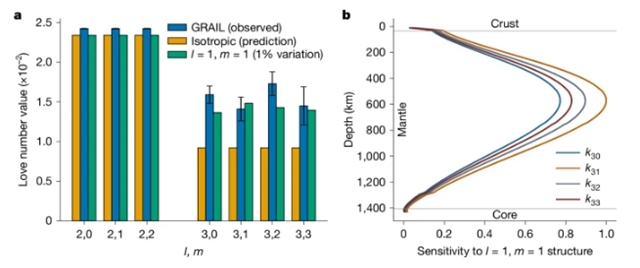
近日,美国加州理工学院Weber, R. C.团队研究了从月潮响应推断月球地幔的热不对称性。2025年5月14日,《自然》杂志发表了这一成果。
由于月球绕地球的偏心和倾斜轨道,它经历了周期性的潮汐强迫。对这种潮汐相互作用的响应驱动了月球重力场的时间变化,并且对卫星的内部结构很敏感。
研究组利用NASA GRAIL航天器的数据,恢复了随时间变化的月球重力场,包括3度引力潮汐Love数k3。研究组报告了他们的估计值k3 = 0.0163±0.0007,比球对称卫星的估计值高72%。
如果地幔的弹性剪切模量在月球近端和远端之间变化约2-3%,可以解释如此大的k3,这提供了月球深部内部横向非均质性的观测证明。这种不对称结构表明保存了大约100-200年的主要热异常。形成表面海区3-4并可能影响深月震的空间分布。
附:英文原文
Title: Thermal asymmetry in the Moon’s mantle inferred from monthly tidal response
Author: Park, R. S., Berne, A., Konopliv, A. S., Keane, J. T., Matsuyama, I., Nimmo, F., Rovira-Navarro, M., Panning, M. P., Simons, M., Stevenson, D. J., Weber, R. C.
Issue&Volume: 2025-05-14
Abstract: The Moon undergoes periodic tidal forcing due to its eccentric and oblique orbit around the Earth1. The response to this tidal interaction drives temporal changes in the lunar gravity field and is sensitive to the satellite’s internal structure2,3,4. We use data from the NASA GRAIL spacecraft5,6,7,8,9 to recover the time-varying lunar gravity field, including a degree-3 gravitational tidal Love number, k3. Here, we report our estimated value of k3=0.0163±0.0007, which is about 72% higher than that expected for a spherically symmetric moon10. Such a large k3 can be explained if the elastic shear modulus of the mantle varies by about 2–3% between the nearside and farside4, providing an observational demonstration of lateral heterogeneities in the deep lunar interior. This asymmetric structure suggests preservation of a predominantly thermal anomaly of roughly 100–200K in the nearside mantle that formed surface mare regions 3–4billion years ago11 and could influence the spatial distribution of deep moonquakes12.
DOI: 10.1038/s41586-025-08949-5
Source: https://www.nature.com/articles/s41586-025-08949-5
Nature:《自然》,创刊于1869年。隶属于施普林格·自然出版集团,最新IF:69.504
官方网址:http://www.nature.com/
投稿链接:http://www.nature.com/authors/submit_manuscript.html
